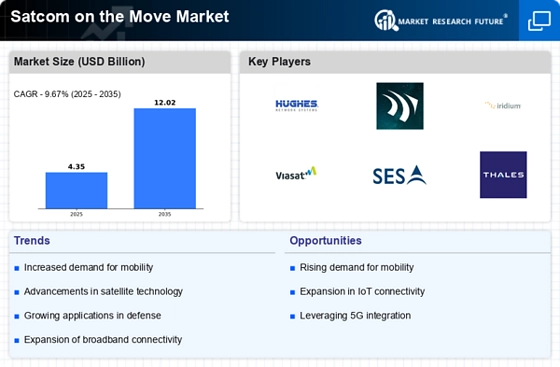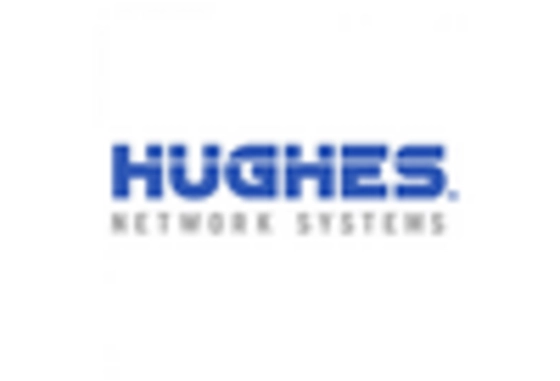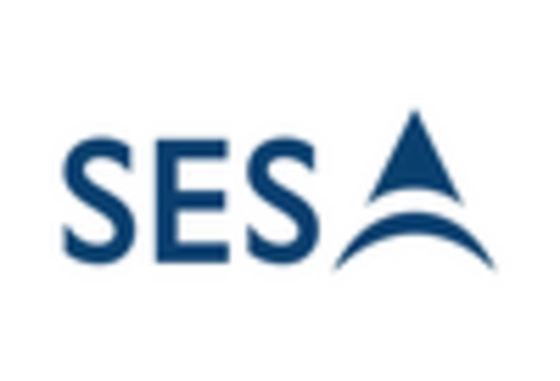Increased Demand for Mobile Connectivity
The Satcom on the Move Market is experiencing a notable surge in demand for mobile connectivity solutions. This trend is driven by the growing reliance on real-time data and communication across various sectors, including transportation, emergency services, and military operations. As organizations seek to maintain operational efficiency, the need for reliable satellite communication systems that can function in motion becomes paramount. Recent data indicates that the market for mobile satellite services is projected to reach USD 5 billion by 2026, reflecting a compound annual growth rate of approximately 10%. This increasing demand underscores the necessity for advanced Satcom on the Move solutions that can provide seamless connectivity in diverse environments.
Expansion of Maritime and Aviation Sectors
The expansion of the maritime and aviation sectors is significantly influencing the Satcom on the Move Market. As global trade and travel continue to increase, the demand for reliable communication systems in these sectors is becoming more pronounced. Satellite communication enables vessels and aircraft to maintain connectivity while operating in remote areas, ensuring safety and operational efficiency. The maritime sector alone is expected to invest over USD 3 billion in satellite communication technologies by 2025. This investment reflects a growing recognition of the importance of Satcom on the Move solutions in enhancing navigation, safety, and operational capabilities. The ongoing expansion in these industries is likely to drive further innovation and adoption of mobile satellite technologies.
Growing Applications in Emergency Services
The Satcom on the Move Market is witnessing a growing application of satellite communication technologies in emergency services. As natural disasters and humanitarian crises become more frequent, the need for reliable communication systems in remote and affected areas is paramount. Satellite communication provides a lifeline for first responders, enabling them to coordinate efforts and deliver aid effectively. Recent reports suggest that the emergency services sector is increasingly investing in mobile satellite solutions, with a projected market growth of 12% annually. This trend highlights the critical role of Satcom on the Move technologies in enhancing situational awareness and operational efficiency during emergencies, thereby solidifying their importance in the overall communication landscape.
Integration of Hybrid Communication Solutions
The integration of hybrid communication solutions is emerging as a pivotal driver in the Satcom on the Move Market. Organizations are increasingly adopting a combination of satellite and terrestrial communication systems to enhance connectivity and reliability. This hybrid approach allows for seamless transitions between different communication modes, ensuring uninterrupted service even in challenging environments. The market for hybrid solutions is projected to grow significantly, with estimates indicating a potential increase of 15% annually over the next five years. This trend reflects a broader shift towards more resilient communication infrastructures, which are essential for mission-critical operations in sectors such as defense, maritime, and aviation. The integration of these solutions is likely to redefine the landscape of mobile satellite communications.
Technological Advancements in Satellite Systems
Technological advancements are playing a crucial role in shaping the Satcom on the Move Market. Innovations in satellite technology, such as the development of low Earth orbit (LEO) satellites, are enhancing the capabilities of mobile communication systems. These advancements enable lower latency and higher bandwidth, which are essential for applications requiring real-time data transmission. The introduction of phased array antennas and software-defined radios further contributes to the evolution of mobile satellite systems. As a result, the market is expected to witness a significant transformation, with estimates suggesting that the satellite communication market could exceed USD 100 billion by 2027. This technological evolution is likely to drive the adoption of Satcom on the Move solutions across various sectors.

















Leave a Comment